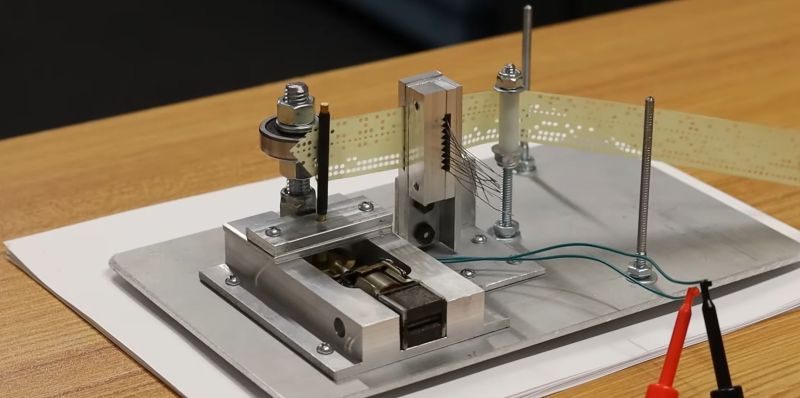Building a paper tape reader by itself isn’t super complicated: you need a source of light, some photoreceptors behind the tape to register the presence of holes and some way to pull the tape through the reader at a reasonable rate. This latter part can get somewhat tricky, as Usagi Electric‘s [David Lovett] discovered while adding this feature to his vacuum tube-era DIY reader. This follows on what now seems like a fairly simple aspect of the photosensors and building a way to position said photosensors near the paper tape.
As the feed rate of the paper tape is tied to the reading speed, and in the case of [David]’s also contains the clock for the custom tube-based UE1 computer, it determines many of the requirements. With 8 bits per line, the tape forms the ROM for the system, all of which has to be executed and used immediately when read, as there is no RAM to load instructions into. This also necessitates the need to run the tape as an endless loop, to enable ‘jumping’ between parts of this paper-based ROM by simple masking off parts of the code until the desired address is reached.
For the motor a slot car motor plus speed-reduction gear was chosen, with a design to hold these then designed in FreeCAD. Courtesy of his brother’s hobby machine shop and a CAD professional’s help, producing these parts was very easy, followed by final assembly. Guides were added for the tape, not unlike with a cassette player, which allowed the tape to be pulled through smoothly. Next up is wiring up the photodiodes, after which theoretically the UE1 can roar into action directly running programs off paper tape.















I’d like to see someone make a punch…
Manual punch/joiner here:
https://www.tindie.com/products/hackmodular/paper-tape-mate/
Designs for it here:
https://github.com/hackmodular/PaperTapePunchBlock
License: CC-BY-SA
A while ago I did a utility to create punched paper tape on a home CNC stencil cutter. It does 8 level ASCII, 5-level Baudot, Cable, Morse, Whirlwind and a few more. It’s slow and fiddly but it works
https://github.com/1944GPW/ptap2dxf
This is pure genius! I hadn’t even considered that path for an automatic tape punch.
I don´t like much that the ball bearing is less wide than the tape. Especially if the motor runs in a continuous loop, it would make sense that the ball bearing housing fits the whole tape and beyond.
So, a roller bearing instead?
I’m not keen on the reader head or the janky washer/guide post in front of it. Nothing to do with his machining or building skills, rather I think the edges of the tape will suffer excessive wear if it is to be in a continuous loop. A smooth channel extending out each side of the read head to where the post is now would reduce wear.
If the paper tape doesn’t have to be very long, it would be simpler to use a cardboard disk or even something like a record player (gramophone) to read the data in a loop.
Not a specialist, but shouldn’t have a guiding sproket running through the smaller holes to properly align the tape to the photodiodes? This will also protect better the tape edges.